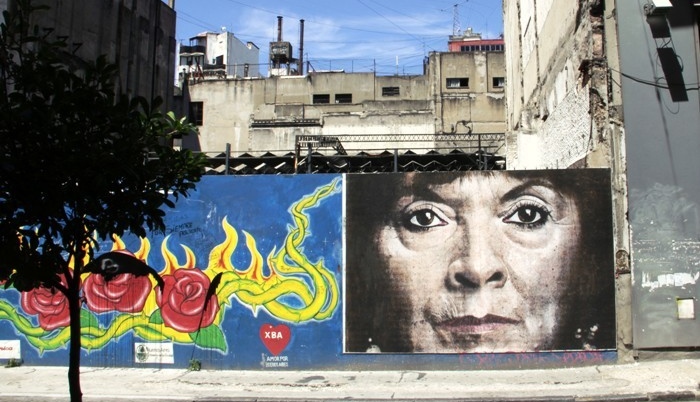
December 21, 2017, by Rights Lab
Picturing Slavery: Learning from Antislavery Murals
As of 2017, every habitable continent in the world houses murals or public art installations dedicated to raising awareness of contemporary slavery. Texturing the streets of Bluefields in Nicaragua, Miami in the United States, New Delhi in India, Freetown in Sierra Leone, and Buenos Aires in Argentina, for example, are contemporary antislavery murals.
Over the last few years, policy-makers have begun to acknowledge the efficacy of murals and artwork as antislavery tools. In 2009, the Executive Director of the United Nations Office on Drugs and Crime explained: “Art is one of the most powerful advocacy tools to raise awareness and move people to take action. A painting says a thousand words…. [and] provides a unique opportunity to implore others to join us in our fight against…modern-day slavery.”
Having researched contemporary antislavery murals, I have noticed that their function falls into two categories: for education, and for rehabilitation. Most common are those created for educational purposes. Murals can be an important step in the process of making cities and communities slavery-free. They can help to raise awareness of local antislavery initiatives, teach communities how to spot the tell-tale signs of slavery, and insert slavery into the public consciousness.
An example of this was visible in Buenos Aires in 2013 when a street artist by the pseudonym of No Touching Ground created a lifelike portrait of Susana Trimarco in the downtown area. Trimarco is a human trafficking activist whose daughter was kidnapped by traffickers. The 10-foot mural on the streets of Buenos Aires celebrates her human rights work.
But the mural’s initial purpose wasn’t only to celebrate her courage. It was also to insert the issue of slavery into a public space and begin a conversation about slavery across Argentina. The high-profile nature of her daughter’s case meant that locals would recognize the portrait, while for tourists visiting the Argentine capital, the story was new. When they sought the identity of the woman in the mural, and asked why her face decorates a busy street in the nation’s capital, they learned about slavery in its numerous forms.
Contemporary antislavery murals are widespread. They also have a long history from which we can learn in order to create more awareness-raising murals today. The antislavery mural has been in existence since the 1920s in the United States, and continued through the 1960s—when 19th-century antislavery figures like Frederick Douglass and Harriet Tubman appeared on America’s walls, offering protest inspiration to civil rights activists. Historical antislavery figures continue to appear in murals today, alongside contemporary leaders.
We have now brought all these historical antislavery murals together. On International Day for the Abolition of Slavery, December 2, 2017, we launched the first major collection of murals about slavery and antislavery: “Walls of Slavery, Walls of Freedom.” I created this archive to ensure these murals remain visible even when damaged or destroyed. We hope to show how murals have long told forgotten antislavery stories for the purpose of galvanizing community activism, and to highlight lessons for the creation of new murals about contemporary slavery and antislavery.
What can we learn from the antislavery mural tradition in this archive? What works to galvanize community activism, and what does not? Some potential lessons might be:
1. Antislavery murals of the past commonly depicted recognizable antislavery figures such as Douglass and Tubman—like the Argentina mural about Susana Trimarco.
2. They often drew upon specific moments during transatlantic slave trade in order to root the mural in historic specificity.
3. They were expansive and frequent, lining the streets of every major US city, to quickly become an artform associated with civil rights activism.
4. They were often accompanied by a dedication ceremony that gave activists a chance to network, share lessons and celebrate successes.
These are just four potential lessons that historical antislavery murals might offer contemporary campaigners. As we work to create slavery-free cities, we can remember that for nearly 100 years, from the 1920s to today, the first generation of abolitionists have been visible on community walls: an ancestry for 20th-century social movements. Today, they offer a usable past for the fight to abolish contemporary slavery.
Hannah Jeffery is completing a PhD at the University of Nottingham funded by the AHRC project “The Antislavery Usable Past.” She is a researcher with the Rights Lab.
No comments yet, fill out a comment to be the first

Leave a Reply